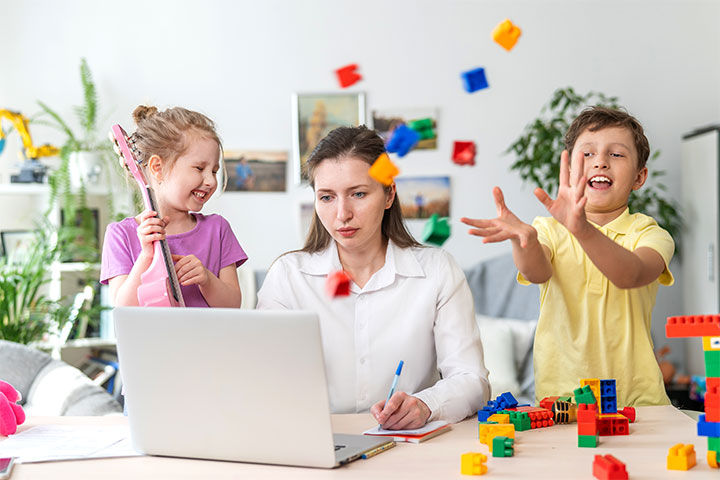
Image: Shutterstock
Parenting is this wild ride full of twists and turns, and sometimes, your child does things that make your emotions shoot through the roof faster than a rollercoaster. One moment, everything’s cool, and the next, it’s like someone pressed a button and whoosh — you’re suddenly boiling mad or super upset. That lightning-fast surge of intense feelings? That’s a trigger. It’s like a sneaky ninja is moving your emotions and pulling on you when something hits a nerve you didn’t even know you had. In this article, we have discussed all about parental triggers and how to deal with them. Read on to know more!
What’s A Trigger?
Image: Shutterstock
A trigger is like a button that gets pushed inside you. It’s something that makes you feel intense emotions. It is often in response to a situation that reminds you of something from your past. It’s not just about being upset or angry; it’s about feeling those emotions much stronger than the situation might call for.
Parental Triggers: What’s That About?
Image: Shutterstock
Parental triggers are those specific buttons that get pushed when your kids do or say something that hits close to home. Maybe it’s when they talk back, and it reminds you of your own childhood, or when they make a mess, and it brings back memories of chaos that stress you out.
Why Do Parental Triggers Happen?
Image: Shutterstock
These triggers happen because of your own experiences and emotions. Things from your past can sneak up on you when your child does something that remotely connects to those memories or feelings. It’s like your brain hits the replay button on an old movie you didn’t even know was still in there.
Identifying Your Parental Triggers
Image: Shutterstock
Recognizing your triggers is a big step. It’s like putting a name to what’s been bothering you. Pay attention to those moments when you feel an intense emotion that seems way bigger than the situation itself. That’s your trigger saying, “Hey, I’m here!” Here are a few ways to identify your triggers:
1. Spotting The Sneaky Triggers
Okay, so these triggers are like ninjas, right? They’re super stealthy and sneak up on you when you least expect it. But guess what? You can totally outsmart them by keeping an eye out for their sneaky tactics.
2. Big Emotions In Small Situations
Ever felt like your reaction didn’t quite match what was happening? Like, your kid forgets their homework, and suddenly, you’re seeing red? That’s the trigger whispering, “Hey, I’m in charge here!” Those moments when your emotions feel like they’re on steroids? Yeah, that’s the cue to look closer.
3. Listen To Your Gut
Your gut’s pretty smart. When something feels off, it usually is. So, if you notice that you’re getting super worked up over something that might seem tiny to others, that’s your gut waving a flag. It’s saying, “Psst! Look here, something’s up!”
4. Patterns In Reactions
Triggers often have a pattern, like a secret code your emotions follow. Maybe it’s a certain phrase or action that always sets you off. When you start noticing these recurring themes in your reactions, you’re getting closer to uncovering those triggers.
5. Physical Clues
Your body’s like a detective, dropping hints left and right. Pay attention to those physical signs — tightness in your chest, clenching your jaw, racing heart—these are often clues that a trigger is lurking nearby.
Dealing With Parental Triggers
Image: Shutterstock
So, what can you do about these triggers? Well, first off, don’t beat yourself up about having them. Everyone has triggers; it’s part of being human. Here are some tips to help you handle them:
1. Pause And Breathe
When you feel those strong emotions coming on, take a breather. Step back, take a deep breath, and give yourself a moment to collect your thoughts. It helps you avoid reacting too quickly.
2. Reflect On Your Triggers
Think about what exactly set you off. Try to connect the dots between what happened and why it made you feel the way you did. Understanding your triggers can help you manage them better next time.
3. Practice Self-Care
Taking care of yourself is crucial. When you’re stressed or tired, triggers can hit harder. So, make time for yourself—get enough sleep, eat well, exercise, and do things that make you happy.
4. Communicate And Seek Support
Talking about your triggers with someone you trust can lighten the load. They might offer a different perspective or share how they deal with similar situations. It’s okay to ask for help.
5. Create Strategies
Once you know your triggers, create a plan. Think about what you’ll do the next time you feel triggered. It might be counting to ten, taking a walk, or even having a phrase that reminds you to stay calm.
Being triggered by your child is tough, but it’s something many parents go through. Remember, it’s okay to feel what you feel, but it’s also important to work on managing those intense emotions. By identifying, understanding, and having strategies to handle your triggers, you’re taking steps toward a healthier and happier relationship with yourself and your child. So, take it easy on yourself, breathe, and remember, you’re doing the best you can.

















